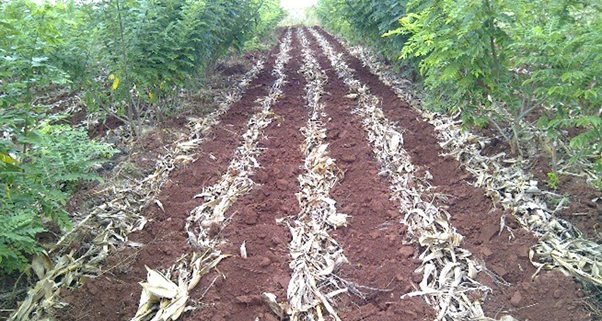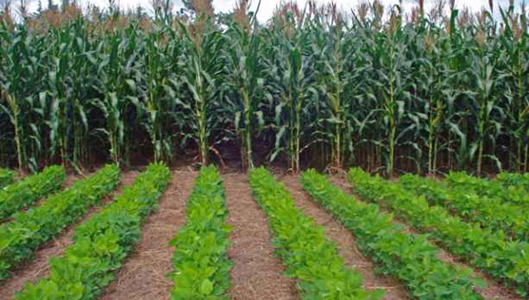Written by: Farirai Rusere (PhD Fellow)
South Africa is generally considered as a food secure nation. However, most rural households that engage in rainfed agriculture are food insecure. Climate change has increased the risks and uncertainties associated with rainfed agriculture. South Africa small scale farmers are not immune to these impacts. The impacts of climate change include changes in rainfall variability and increased temperatures which lead to extensive droughts and heat stress lowering crop productivity particularly in many rural areas of sub Saharan Africa. The World Food Programme (WFP 2016) report shows that crop production yield per hectare is, on average, increasing at a rate below that of global populations, implying that food production, which has been unable to meet global demand, will struggle to do so in the immediate future, leaving millions of people and numerous countries facing the stark reality of having reduced food security. Lobell et al. (2008) argue that to increase food production, yield per hectare must increase thus agricultural production must be intensified. If yield per hectare increases at a rate slower than that of population, then food shortages experienced throughout the world will only get worse, aided by global warming. The effects of global warming on crops depend greatly on region and type of crop. It is worth noting that global population is continuing to rise and the rates at which climate change and production of agriculture and food have been increasing are not equal. South Africa’s population is growing at almost 2% per year. The population of 49 million in 2009 is expected to grow to 82 million by the year 2035. Food production or imports must more than double to feed the expanding population, and production needs to increase using the same or fewer resources. In addition, to the need for increased food production, agriculture must be aligned to the green economic management growth and sustainable development goals for improved management of agricultural landscapes.
South Africa has a dual agriculture economy characterised by a dual agricultural economy consisting of a well-developed commercial sector and smallholder, often subsistence, farming. While commercial farms take up approximately 87 % of the agriculture land, small-scale farms of approximately two million smallholder or household farmers, however, only occupy 13 % of the total agricultural land (FAO, 2003). Agriculture in South Africa faces a few challenges, that include changes in land tenure and production intensity. In several well-developed commercial farms increased productivity and intensification has occurred and these commercial farms contribute significantly to the food production and national food security. On the other hand, subsistence farming is more geared towards sustaining the livelihoods of South African rural households and many of these rural household predominantly rely on land to feed their families. Although both sectors are faced with several challenges including uncertainty over land tenure and climate change and variability, currently the smallholder subsistence agriculture sector is largely vulnerable to climate change and variability. With population growth occurring rapidly in these rural areas, this will result in high population densities, a decrease in arable land, compounded by the expected negative effects of climate change in South Africa, this will result in severe food insecurity in rural households. To buffer smallholder farmers against a rapidly changing climate and severe food security, South Africa needs to support sustainable climate smart agricultural intensification approaches in the smallholder farming sector that enable both adaptation and mitigation to climate change and variability to ensure long term productivity with minimal negative impact on the environment and the climate system, otherwise environmental and social problems will persist. Currently, focus has been on how smallholder farmers can adapt to the changing climate but not much attention has been paid on their mitigation potential. Although some might argue that their mitigation potential is insignificant considering that they are on 13% of South Africa agricultural land. But there is broad agreement agriculture must intensify, and it must come together with environmental sustainability otherwise environmental and social problems will persist.
Against this backdrop, I examine how do we intensify in smallholder agricultural systems in South Africa without doing harm to the environment. Smallholder agricultural systems on the continent and in South Africa in particular, are complex and diverse have generally been less intensive. They have relied more on ecological processes i.e. ecosystem services and functions. Two paradigms namely sustainable and ecological intensification have significantly gained momentum in the scientific and development world and are aimed at smallholders in developing countries to increase production and ensure environmental sustainability. In addition, smallholder agriculture in Africa is better positioned to adopt the key tenets of increasing production without causing undue harm to the environment. Assessing productivity increases is relatively easy as most farmers estimate yield increases. Although various tools have been developed to assess progress towards sustainable agriculture. Assessing environmental sustainability has always been a challenge because of lack of agreement about what should be measured, this has led to a great deal of confusion and frustration, particularly for the smallholder farmers It has also left smallholder farmers unsure about what really constitutes sustainable agricultural production. But if we are going to talk sustainability, let us define what we mean by sustainability. One way to start is to consider the planetary boundaries. For any agricultural model to be considered sustainable it must allow us to stay within a safe operating space in our earth system, considering these nine global indicators, and propend towards social equity while safeguarding cultural diversity and values. Unfortunately, that’s not the case at the moment. We have already crossed some critical boundaries and agriculture is largely responsible for that.
To transition towards sustainability, our agricultural research for development efforts should contribute to:
- Reduce the dependence of agriculture on non-renewable resources
- Reduce its impacts on the environment and nature (soil, water, air, organisms, genomes)
- Restore the productive capacity of degraded soils
- Reduce the current expansion of the agricultural frontier onto marginal and or biodiversity rich areas
- Maximise the resource use efficiency through optimisation of ecological processes
- Adapt to and contribute to mitigate climate change
- Promote the necessary technological and organisational innovations
- Design compatible value chains and guarantee systems
- Offer opportunities for farming families to remain in rural areas
- Align the agricultural agenda with the UN Sustainable Development Goals
If we can agree on these 10 set goals we can achieve sustainability or by the same token climate smart agricultural intensification needed to feed the world, adapt and mitigate climate change.

